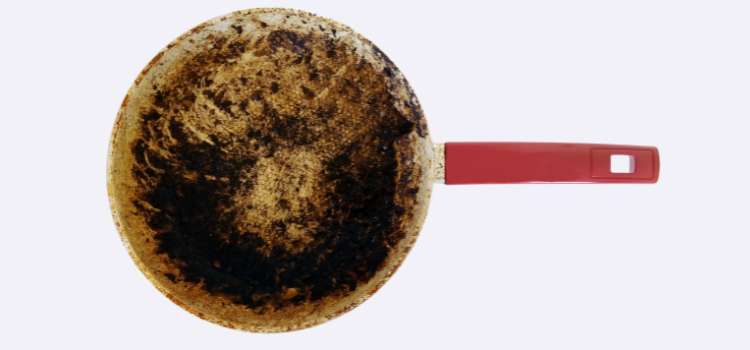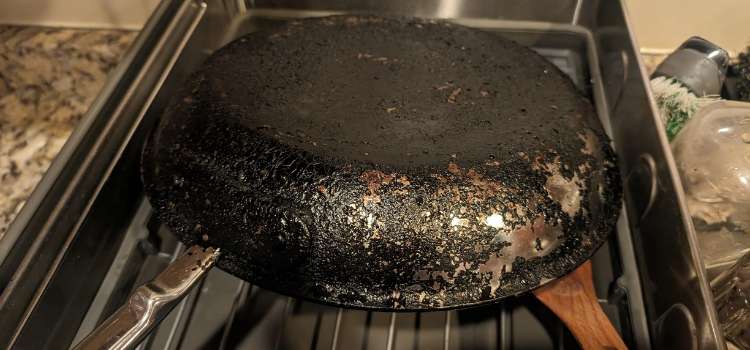As an Amazon Associate, I earn from qualifying purchases

Frying pans are indispensable in our kitchens, handling everything from a quick omelet to a hearty stew. However, a common and frustrating issue many cooks face is dealing with burnt grease that stubbornly clings to the bottom of these pans.
This burnt residue not only makes your cookware look unsightly but also impacts its performance, potentially causing uneven heating and altering the taste of your food. Over time, if not addressed, this buildup can become a breeding ground for bacteria and lead to damaging the integrity of your pans.
Regular maintenance becomes crucial in extending the life of your cookware and ensuring your culinary creations remain top-notch. In this article, we’ll explore effective methods to tackle this greasy challenge, restoring your pans to their gleaming best.
Materials Needed for Cleaning
Before we dive into the cleaning process, let’s gather the materials you’ll need. Having the right tools on hand can make the task more efficient and less cumbersome:
- Baking Soda: A powerful yet gentle abrasive.
- Vinegar: Known for its grease-cutting properties.
- Dish Soap: Essential for breaking down grease and grime.
- Scrub Brush: Helps in scrubbing away the loosened grease.
- Non-Abrasive Sponge: Ideal for cleaning without scratching surfaces.
- Optional Tools: A scraper for stubborn spots or steel wool, though to be used sparingly to prevent scratching.
Equipped with these, you’re ready to tackle even the toughest burnt grease challenges.
Step-by-Step Cleaning Methods

- Pre-soak: Begin by filling your sink with hot, soapy water. Immerse the pan and let it soak for about 20-30 minutes. This step softens the grease, making it easier to remove.
- Scrubbing: After soaking, use a scrub brush or non-abrasive sponge to scrub the pan. Focus on the burnt areas, applying firm pressure. If you’re using a scraper, gently scrape the areas to lift off the loosened grease.
- Baking Soda Paste: For persistent stains, create a paste by mixing baking soda with a little water. Apply this paste to the affected areas and let it sit for about 10 minutes. Baking soda’s mild abrasiveness will help lift off stuck-on grease without damaging the pan.
- Final Rinse: Once the grease is removed, rinse the pan thoroughly with warm water to wash away any soap or baking soda residues. Dry it immediately with a clean towel to prevent water spots.
Natural Cleaning Solutions
Sometimes, turning to natural solutions can be both effective and environmentally friendly. Here are a few methods that harness household ingredients:
- Vinegar and Baking Soda: This dynamic duo is a favorite for tackling grease. Sprinkle baking soda over the greasy area, then spray vinegar on top. The fizzing action helps break down grease. After a few minutes, scrub and rinse.
- Lemon Juice and Salt: Combine the acid of lemon juice with the grit of salt to power through grease. Rub the mixture onto the grease spots, let it sit, then scrub and rinse.
- Coca-Cola Method: Coca-Cola isn’t just a refreshing drink; its acidic properties can help dissolve stubborn grease. Pour a small amount into the pan, let it sit for about an hour, then scrub and rinse well.
Tips for Preventing Future Buildup
Preventing burnt grease buildup is easier than tackling it after the fact. Here are some strategies to keep your pans in pristine condition:
- Regular Cleaning: Make it a habit to clean your pans after each use before grease has a chance to harden and accumulate.
- Splatter Guard: Use a splatter guard when frying to minimize grease splatters that can lead to buildup.
- Correct Cooking Temperature: Avoid cooking on excessively high heat, which can cause grease to burn and stick to the pan. Use medium to low heat settings for most frying tasks.
Conclusion
In conclusion, maintaining your frying pans requires a bit of effort, but the benefits are well worth it. Regular and proper cleaning not only keeps your pans looking new but also ensures they perform optimally, contributing to better-tasting meals.
By incorporating natural solutions and consistent cleaning habits, you can protect your kitchen investments and make cooking a joy rather than a chore. Remember, a little preventative care goes a long way in preserving your cookware’s longevity and efficiency. Happy cooking!
FAQ
How to get grease off the bottom of a frying pan?
To remove grease, soak the pan in hot, soapy water for 30 minutes. Then, scrub with a mix of baking soda and water using a non-abrasive sponge. Rinse thoroughly and dry to prevent water spots and restore cleanliness.
How to clean the bottom of a burnt frying pan?
Start by soaking the pan in warm, soapy water to loosen burnt residues. Scrub with a paste made of baking soda and water. For stubborn stains, use vinegar and baking soda to create a fizzing reaction that helps lift the burnt material.
How to remove burnt oil from a frying pan?
Cover the burnt area with baking soda, then pour vinegar over it to create a fizz. Let it sit for 10 minutes before scrubbing with a sponge. Rinse thoroughly to ensure all residues are removed, leaving your pan clean and fresh.
How do you restore the bottom of a frying pan?
Restore the pan by gently scrubbing with a paste of baking soda and water. For tough spots, use a vinegar and baking soda solution. Rinse well and dry immediately. Maintain by avoiding high heat and cleaning regularly to preserve its condition.
As an Amazon Associate, I earn from qualifying purchases